Mid-year Observation of the Automobile Market | Strong Performance of Domestic Brands, New Energy Vehicles Become a Highlight
2024-09-02
In the first half of 2024, with the continued implementation of favorable policies such as trade-ins and new energy vehicle rural promotion, automakers accelerated the research and development of new technologies and new models. Coupled with automakers' rush to increase sales at the semi-annual node, the consumption potential of the automotive market was further released, and automobile production and sales maintained steady growth. Data released by the China Association of Automobile Manufacturers (CAAM) shows that from January to June this year, automobile production and sales reached 13.891 million and 14.047 million units respectively, an increase of 4.9% and 6.1% year-on-year.
According to the China Association of Automobile Manufacturers, the main economic indicators of the automotive industry have shown a growth trend since the beginning of this year. In the first half of the year, domestic automobile sales increased slightly year-on-year, and terminal inventory was higher than normal levels. The market share of Chinese brand passenger vehicles exceeded 60%, achieving an upward breakthrough. The market share of new energy vehicles steadily increased, and automobile exports maintained rapid growth, making a significant contribution to the overall growth of the market.
Chinese independent brands continue to rise, with a market share exceeding 60%
In the first half of 2024, the market share of Chinese independent auto brands steadily climbed, with Chinese brand passenger vehicles accounting for over 60% of the domestic market, setting a new historical high. As independent brands continue to make breakthroughs in technological strength, and consumer recognition of independent brands continues to improve, Chinese independent auto brands are undergoing a historic transformation, and the automotive market landscape is being reshaped.
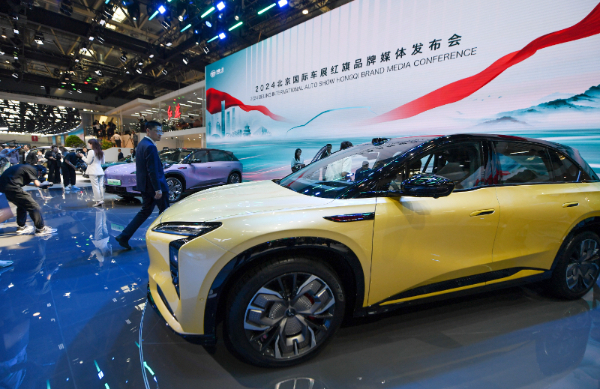
From the perspective of enterprise market data, from January to June this year, six of the top ten automobile groups in terms of sales volume achieved positive year-on-year growth. Many automakers, including BYD, Chery, Changan Automobile, Geely Automobile, and Dongfeng Motor, showed significant growth, delivering satisfactory results.
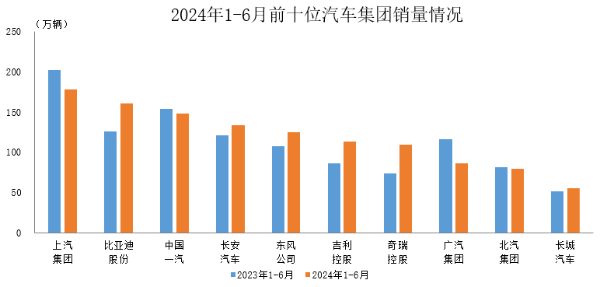
Source: CAAM
Among independent brand automakers, BYD has been leading the way. In the first half of the year, BYD's passenger vehicle sales totaled 1.613 million units, a year-on-year increase of 28.46%. Since the beginning of this year, BYD has successively launched several Honor Edition models, which have been well received in the market. Changan Automobile and Chery Group's cumulative sales reached 1.3341 million units and 1.1006 million units respectively. Among them, Chery Group's semi-annual sales exceeded one million units for the first time, setting a new historical high. Geely Automobile's cumulative sales in the first half of the year reached 955,700 units, a year-on-year increase of 41%, successfully completing the "half-year exam" with nearly one million units. In view of this, Geely has increased its annual sales target by about 5%, from 1.9 million units to 2 million units.
In contrast, the top ten joint venture brand automakers all experienced a year-on-year decline in sales. A research report from CICC pointed out that the technological barriers established by joint venture automakers in the fuel vehicle field are gradually being weakened, while their technological capabilities, product strength, and brand awareness in the electric vehicle field have not yet been formed, and the optimal window period for electric transformation is gradually narrowing. In the future, Chinese joint venture automakers face three options: firstly, firm transformation and localization; secondly, cooperating with Chinese automakers like Volkswagen to make up for shortcomings; and thirdly, withdrawing from the Chinese market.
At the performance exchange meeting in March this year, BYD stated that once domestic enterprises improve their technology and achieve cost leadership, Chinese brands will have greater growth potential in the next 3-5 years, seizing more market share from joint venture brands.
New energy vehicles achieve breakthroughs, market share reaches 35.2%
China's new energy vehicle production and sales have ranked first in the world for nine consecutive years, and have shown a good situation of both scale and quality improvement. Fu Bingfeng, executive vice president and secretary-general of the China Association of Automobile Manufacturers, said that China's new energy vehicles have grown from nothing to something big, and have transformed their first-mover advantage into a leading advantage.
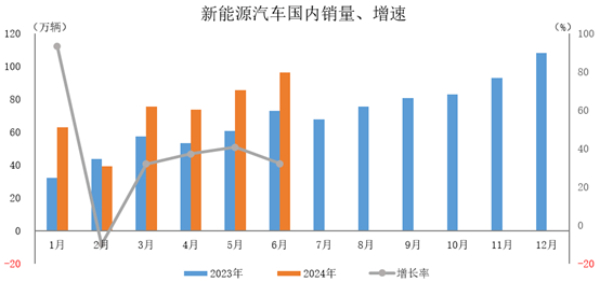
Source: CAAM
From January to June this year, the production and sales volume of new energy vehicles in China reached 4.929 million and 4.944 million units respectively, a year-on-year increase of 30.1% and 32%, with a market share of 35.2%. By the end of June, the cumulative production and sales volume of domestically produced new energy vehicles exceeded 30 million units. New energy vehicles not only continued their rapid growth, but also showed a diverse landscape. In addition to independent brands continuously increasing investment, joint venture automakers have also transformed to embrace the Chinese new energy vehicle market, jointly promoting the continuous increase in the market share of new energy vehicles. In June, the market share of new energy vehicles in China once reached 41.1%.
Li Chao, deputy director and spokesperson of the Policy Research Office of the National Development and Reform Commission, said, "The new development concept has provided guidance for the development of China's new energy vehicle industry, and China's ultra-large-scale market has provided broad development space for the new energy vehicle industry. In addition, sufficient market competition has forged the competitiveness of the new energy vehicle industry."
The competition of technological routes for new energy vehicles has always been a focus of attention. Plug-in hybrid vehicles, once considered "transitional technology," are gradually entering the mainstream view. From the detailed data, from January to June, the production and sales of pure electric vehicles in China reached 2.99 million and 3.019 million units respectively, a year-on-year increase of 9.4% and 11.6%; the production and sales of plug-in hybrid vehicles reached 1.937 million and 1.922 million units respectively, a year-on-year increase of 83.9% and 85.2%.
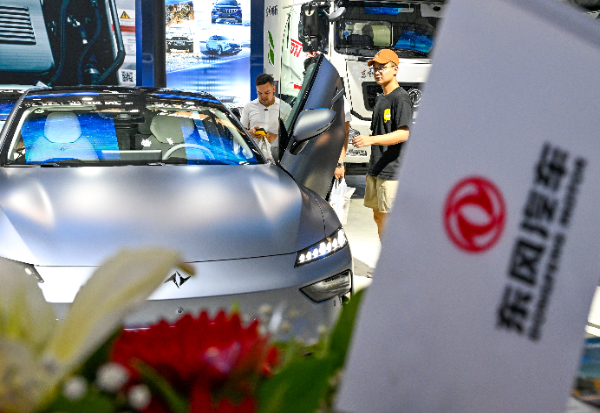
"In the first half of this year, the growth rate of pure electric vehicles slowed down, and the high growth of China's new energy vehicle production and sales mainly relied on the driving force of plug-in hybrid vehicles." Chen Shihua, deputy secretary-general of CAAM, said.
In recent years, a number of new car-making forces have rapidly risen with their innovation and flexibility, and cross-border car-making companies such as HarmonyOS Zhixing and Xiaomi have surged, making this track full of vitality. Currently, HarmonyOS Zhixing, which is in the first echelon, has accumulated sales of 194,207 units in the first half of the year, and Li Auto has accumulated sales of 188,981 units in the first half of the year, which also reflects the upward trend in the extended-range market.
To meet the different needs of consumers, some automakers have named the plug-in hybrid system as extended-range electric, while others have proposed the concept of pure electric, hybrid, and extended-range three-in-one. In March this year, Dongfeng released the Mach Electric Hybrid PHREV technology, "PHREV" is the abbreviation of PHEV (plug-in hybrid) and REEV (extended-range), integrating the advantages of pure electric, extended-range, and plug-in hybrid three technical schools; similarly, in March, the Changan UNI-Z, which is equipped with the new Blue Whale power platform, was released, which can seamlessly switch between pure electric, plug-in hybrid, and extended-range driving modes through algorithms.
Exports surge to create excellent results, fuel vehicles provide important driving force
In recent years, Chinese auto companies have actively deployed overseas markets. From Southeast Asia to Europe, from Africa to South America, Chinese cars are driving towards the world. In this process, Chinese auto companies have continuously enhanced their competitiveness in the international market by optimizing product design, improving quality standards, and strengthening after-sales service networks.
From January to June this year, China exported 2.793 million vehicles, a year-on-year increase of 30.5%, maintaining rapid growth. Chen Shihua, deputy secretary-general of CAAM, analyzed that Chinese automobiles have performed well in the international market, and exports have become an important force supporting China's current automobile market.
Among the top ten companies in terms of vehicle export sales, in terms of growth rate, BYD exported 207,000 units, a year-on-year increase of 1.6 times; Great Wall exported 202,000 units, a year-on-year increase of 62.6%; Changan exported 285,000 units, a year-on-year increase of 60.4%.
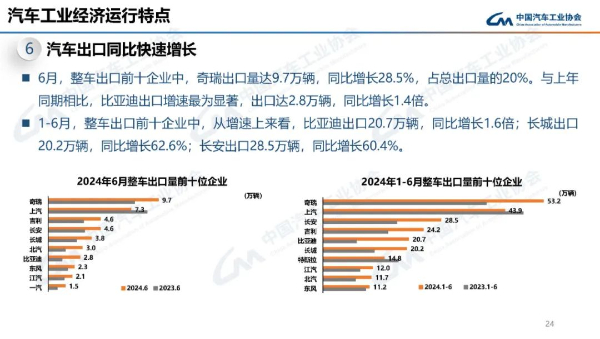
Source: CAAM
From January to June this year, exports of traditional fuel vehicles reached 2.188 million units, a year-on-year increase of 36.2%; exports of new energy vehicles reached 605,000 units, a year-on-year increase of 13.2%. This shows that the rapid growth of China's automobile exports in the first half of the year was mainly driven by traditional fuel vehicles, while the export growth rate of new energy vehicles slowed down. "The current international trade protectionism situation is becoming more severe, and new energy vehicle exports are facing greater pressure." said Chen Shihua, vice secretary-general of the China Association of Automobile Manufacturers (CAAM).
Looking ahead, Cui Dongshu, secretary-general of the China Passenger Car Association (CPCA), believes that after the price war in the first half of the year, it is expected that automakers will optimize their market expectations, product structure, and launch rhythm, and the market may enter a period of accumulation in the next one or two months. Chen Shihua, vice secretary-general of CAAM, believes that consumer confidence and the market environment need to be further boosted and improved to help the automotive industry operate steadily.
(Article from Xinhua Net)
Previous:
Recommended News



